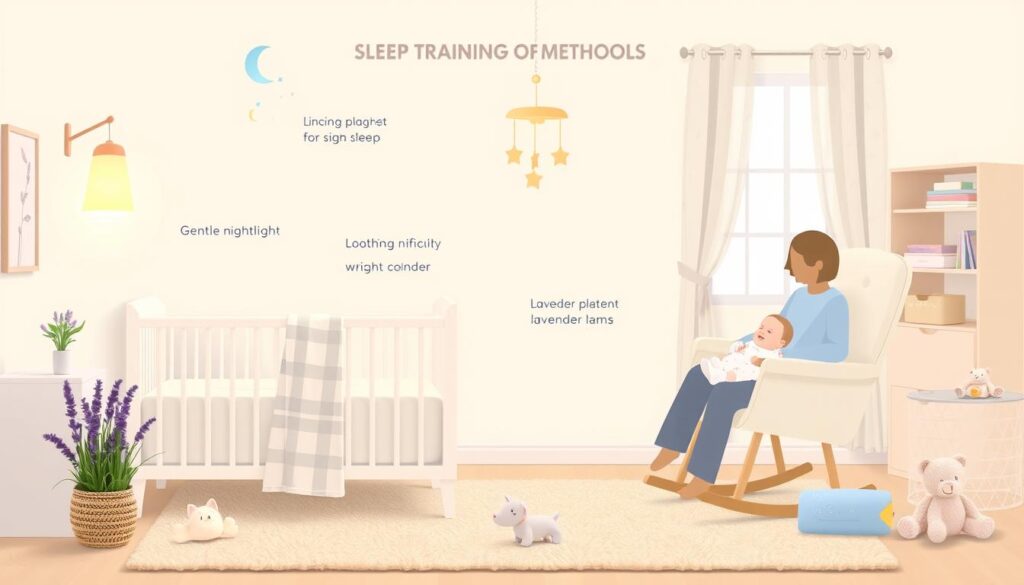Creating a consistent sleep routine is key for your baby’s health and growth. As a new parent, figuring out your baby’s sleep patterns can be tough. But, with the right steps, you can help your baby sleep well and feel better too. This guide will show you how to make a good sleep routine for your baby, from knowing their sleep needs to using soothing methods for sleep.
Contents
- 1 The Importance of a Baby Sleep Routine
- 2 Understanding Your Baby’s Sleep Needs
- 3 Creating a Calm Sleep Environment
- 4 Establishing a Bedtime Schedule
- 5 The Role of Feeding in Sleep
- 6 Calming Techniques for Babies
- 7 Incorporating a Wind-Down Routine
- 8 Dealing with Sleep Regression
- 9 Encouraging Self-Soothing
- 10 Understanding Sleep Training Methods
- 11 Common Sleep Challenges and Solutions
- 12 When to Seek Professional Help
- 13 FAQ
- 13.1 What are the benefits of establishing a consistent baby sleep routine?
- 13.2 How do a baby’s sleep needs change as they grow?
- 13.3 What elements are important for creating a calm sleep environment for a baby?
- 13.4 How do feeding and nighttime feedings impact a baby’s sleep routine?
- 13.5 What calming techniques can help settle babies for sleep?
- 13.6 How can parents encourage self-soothing in their babies?
- 13.7 What are the different sleep training methods available, and how do I choose the right one for my family?
- 13.8 When should I seek professional help for my baby’s sleep issues?
Key Takeaways
- Understand the importance of a consistent baby sleep routine for your child’s health and your own well-being.
- Learn how to create a calming sleep environment that promotes restful sleep for your baby.
- Discover effective techniques to establish a bedtime routine and encourage healthy sleep patterns.
- Explore ways to address common sleep challenges, such as sleep regressions and sleep associations.
- Recognize when to seek professional help for your baby’s sleep issues and find the right resources.
The Importance of a Baby Sleep Routine
Creating a consistent sleep routine is key for your baby’s health. A predictable bedtime ritual brings many benefits. It helps your baby’s health and makes parenting easier for you.
Benefits for Baby’s Health
A regular sleep routine helps your baby’s body keep a natural sleep cycle. This ensures they get the sleep they need to grow well. It also boosts their brain, mood, and body growth.
Consistent sleep patterns make their immune system stronger. This lowers the chance of getting sick and keeps them healthy overall.
Benefits for Parents’ Well-being
When your baby sleeps well, so do you. A well-rested baby means you get more sleep too. This leads to less stress, a better mood, and more energy.
With more energy, you can focus better on your parenting. This strengthens your bond with your child.
Establishing Healthy Sleep Patterns
By sticking to a baby sleep routine and establishing bedtime rituals, your baby learns healthy sleep habits. These habits will help them sleep well for years to come.
“A good night’s sleep is essential for a baby’s growth and development. Establishing a consistent bedtime routine can make all the difference.”
Understanding Your Baby’s Sleep Needs
As your newborn grows, their sleep patterns change. Knowing the typical sleep schedules and signs of sleep readiness helps you create a routine. This routine is tailored to your baby’s unique needs.
Newborn Sleep Patterns
Newborns sleep a lot, usually 16-18 hours a day. Their sleep is often broken, with frequent waking for feeding and diaper changes. Newborns may sleep in short bursts of 2-4 hours, both day and night.
This irregular sleep schedule can be tough for parents. But it’s a natural part of their growth.
Sleep Requirements by Age
- Newborns (0-3 months): 14-17 hours per day
- Infants (4-11 months): 12-15 hours per day
- Toddlers (1-2 years): 11-14 hours per day
As your baby grows, their sleep needs decrease. But a consistent routine ensures they get the rest they need.
Signs of Sleep Readiness
Knowing when your baby is ready for sleep helps time naps and bedtime better. Common signs include:
- Yawning
- Rubbing eyes
- Fussiness or crankiness
- Decreased activity and engagement
By paying attention to these cues, you can help your baby establish a regular sleep pattern. This ensures they get the rest they need to thrive.

Creating a Calm Sleep Environment
Creating a safe sleep environment is key for babies to sleep well. By managing the room’s temperature, bedding, and noise, parents can make a cozy space for sleep.
Ideal Room Temperature
The best room temperature for a baby’s sleep is between 68°F and 72°F (20°C to 22°C). This keeps them from getting too hot or cold, which can mess with their sleep. Keeping an eye on the temperature and adjusting it helps your baby stay cozy all night.
Choosing the Right Bedding
Choosing the right bedding is vital for a safe sleep environment. Go for breathable, snug sheets and avoid loose blankets or comforters that could be dangerous. Soft, hypoallergenic materials like organic cotton are safe and comfy for your baby.
Reducing Noise and Light
Less noise and light can greatly improve a baby’s sleep. Using white noise for babies can create a calming sound that blocks out other noises. Blackout curtains or blinds can also keep out unwanted light from windows.
“Creating a peaceful, distraction-free sleep environment is one of the most important steps in establishing a healthy sleep routine for your baby.”
Adjusting the temperature, bedding, and lighting in your baby’s room can make a safe sleep environment. These simple steps can greatly improve your baby’s sleep quality and health.
Establishing a Bedtime Schedule
Creating a bedtime routine is a big help for your baby’s sleep. A regular schedule means peaceful sleep for everyone. It’s good for your baby and you too.
Ideal Bedtime Routines
The best bedtime routines are the same every night. They tell your baby it’s time to sleep. Activities like a warm bath, cozy clothes, a story, and lullabies are great. Keep the order the same so your baby knows it’s sleep time.
Duration of Sleep Sessions
Newborns sleep 14-17 hours a day, in sessions of 2-4 hours. As they grow, they sleep less, but a bedtime schedule is still key. Toddlers need 11-14 hours of sleep, best between 7-8 PM.
Consistency and Flexibility
- Stick to a bedtime, but be flexible when needed.
- Change the routine for travel or daylight saving time.
- Be patient and keep trying – adjusting to a new schedule takes time.
Setting up a baby sleep routine and bedtime rituals takes effort, but it’s worth it. A calm, predictable place helps your baby sleep well. This supports their growth and health.

The Role of Feeding in Sleep
Feeding is key for a newborn’s sleep routine. As parents, knowing how feeding and sleep work together helps set a good sleep schedule. Let’s look at how these two interact and find ways to improve your baby’s sleep.
Feeding Before Sleep
Feeding your baby before bed can help them relax and sleep better. The dream feeding method, where you feed a sleepy baby, can make their sleep last longer. But, be careful not to overfeed, as it can cause discomfort and wake them up.
Nighttime Feeding Strategies
- Make a consistent newborn sleep schedule with regular feedings during the day and night.
- Try the dream feeding method to make sure your baby is fed well before bed.
- Listen to your baby’s hunger signs at night to avoid fussiness and improve sleep.
Weaning Off Night Feeds
As your baby gets older, you might need to stop nighttime feedings. This should be done slowly and based on your child’s needs. Start by reducing how often and how long you feed at night. Make sure they eat enough during the day. With time and patience, your baby can learn to sleep all night without needing to be fed.
“Feeding and sleep are intricately linked in a baby’s world. By understanding and addressing this connection, parents can create a nurturing environment that supports their child’s overall well-being and development.”
Calming Techniques for Babies
Soothing a fussy baby can be tough, but there are many ways to help. Swaddling, rocking, and swaying are just a few. These methods can greatly improve your baby’s sleep routine.
Swaddling for Comfort
Swaddling is a classic method that offers comfort and security. It wraps your baby in a soft blanket, like the womb. This can calm their startle reflex and help them sleep better. When done right, swaddling can be a big help for parents.
Rocking and Swaying
The gentle motion of rocking or swaying can put babies to sleep. You can use a rocking chair or just sway while holding your child. Try different speeds and patterns to see what works best for your baby.
Soothing Sounds
Calming sounds, like white noise, can also help babies sleep. Sound machines or lullabies can block out noise and create a calm space. Try different sounds to see what your baby likes best.
Using these calming techniques can make your baby’s sleep better. Every baby is different, so be patient and find what works for your family.
“Swaddling can be a game-changer for parents seeking to soothe their little one.”
Incorporating a Wind-Down Routine
Creating a bedtime routine is key for your baby’s peaceful sleep. A wind-down routine includes calming activities that tell your baby it’s time for sleep. This routine helps your baby sleep better and fall asleep easier.
Activities to Signal Sleep
Here are some calming activities for sleep time:
- A warm bath
- Gentle massage with soothing lotions
- Reading a bedtime story
- Singing lullabies or playing soft, soothing music
- Dimming the lights and using night lights
Duration of Wind-Down Time
The best wind-down time is 30 to 45 minutes. This lets your baby relax and get ready for sleep. Some babies need more time, while others need less.
The Best Time to Start
Start your baby’s wind-down routine 30 minutes before bedtime. This helps them smoothly go from play to sleep. Being consistent with the routine and timing is important.
“A consistent bedtime routine helps babies learn to associate certain activities with sleep, making it easier for them to wind down and fall asleep on their own.”
Adding a calming wind-down routine to your baby’s schedule helps them sleep better. Every baby is different, so try different activities and times to find what works best for your baby.
Dealing with Sleep Regression
As your little one grows, they may face sleep regression. This is when their sleep patterns change suddenly. It’s a normal part of growing up, but it can be tough for parents.
Common Sleep Regression Periods
Sleep regressions happen at certain ages, like 4, 6, 8, and 12 months. During these times, babies might find it hard to fall asleep. They may wake up more often at night and sleep less overall.
Strategies to Cope
- Keep your bedtime routine the same. It helps your baby feel secure.
- Add things like white noise, swaddling, or a favorite toy to help them relax.
- Be patient and flexible. Sleep regressions are temporary, and things will get better.
When to Consult a Pediatrician
If your baby’s sleep problems last more than a few weeks or upset them a lot, talk to your pediatrician. They can check for health issues and give advice to help your baby sleep better.
“The key during sleep regressions is to remain calm and consistent. Stick to your routines, provide comfort, and know that this too shall pass.”
Knowing about sleep patterns and having ways to deal with them helps parents. Remember, your pediatrician is there to help you and your baby with sleep issues.

Encouraging Self-Soothing
Parents are on a journey to help their babies sleep well. A key skill is self-soothing. This means a baby can calm down and sleep on their own, without needing to be rocked or fed.
Learning this skill is good for both babies and their parents. It helps everyone get better sleep in the long run.
What is Self-Soothing?
Self-soothing is when a baby uses their own ways to relax and fall asleep. This can be sucking their thumb, stroking their face, or holding a comfort object. It’s a way for babies to calm down and sleep by themselves.
This skill helps babies control their feelings and sleep better on their own. It’s a big step in growing up.
Techniques to Promote Self-Soothing
There are many ways to help babies learn to soothe themselves. Here are a few:
- Give them a comfort object, like a soft toy or blanket, to hold during sleep time.
- Make a bedtime routine that tells the baby it’s time to sleep.
- Let them cry for a little while before you help them. This lets them learn to calm down on their own.
- Slowly stop doing things like rocking or feeding them to sleep. This helps them learn to sleep without your help.
Benefits for Long-Term Sleep
Teaching babies to soothe themselves can help them sleep better for a long time. Babies who can soothe themselves sleep through the night more often. They wake up less during the night and move between sleep stages easily.
This means babies and parents get more rest. A well-rested family is happier and healthier.
Encouraging self-soothing is key to a healthy sleep routine for babies. By understanding and using the right techniques, parents can help their babies sleep well for years to come.
Understanding Sleep Training Methods
As parents, finding the right sleep routine for your baby can be tough. Luckily, there are many sleep training methods to help. These range from the cry-it-out method to gentle, no-tears approaches. Knowing your options helps you pick the best one for your family.
Different Sleep Training Approaches
Here are some common sleep training methods:
- Cry-It-Out (CIO): This method lets your baby learn to fall asleep alone, even if they cry a bit.
- Graduated Extinction: Also known as the “Ferber Method,” it helps your baby get used to sleeping by themselves by gradually increasing the time between your responses to their cries.
- No-Tears: Techniques like the Chair Method or the Sleep Fading Method are gentler. They help your baby sleep without crying too much.
Choosing the Right Method for Your Family
When picking a sleep training method, think about your baby’s personality, your parenting style, and your family’s sleep needs. Some methods might suit certain babies better than others. Be ready to try different approaches until you find the right one.
Tips for Successful Sleep Training
Consistency and patience are crucial for sleep training success. Keep a regular bedtime routine, make the sleep area calm, and be there to comfort your baby. Every baby is different, so it might take time to find the best method for your family.
Understanding co-sleeping’s pros and cons is also key. Co-sleeping can strengthen your bond but might make independent sleep harder. Weigh the good and bad sides to decide what’s best for your family.

Common Sleep Challenges and Solutions
Parents often face challenges when trying to get their babies to sleep well. Issues like nightmares, night terrors, teething, and sleep associations can affect a child’s sleep. But, there are ways to overcome these problems and help your baby sleep better.
Nightmares and Night Terrors
Nightmares and night terrors can upset both babies and parents. Nightmares can be calmed with comfort and reassurance. For night terrors, it’s best to comfort the child without waking them up.
Teething Troubles
Teething can make it hard for babies to sleep. To help, offer soothing items like teething rings or pacifiers. Also, talk to your pediatrician about using pain relievers.
Sleep Associations
Babies often rely on certain things to fall asleep. While these can be comforting, they can also be a problem if the baby can’t sleep without them. Helping your baby learn to fall asleep on their own can break these sleep associations.
By tackling these common sleep issues, parents can help their babies sleep better. This ensures both the baby and the parents are well-rested and happy.
“A well-rested baby is a happy baby, and a well-rested parent is a happier parent.”
When to Seek Professional Help
Creating a good sleep routine is key for your baby’s health. Sometimes, you might need help from a professional. Knowing when to ask for a pediatric sleep specialist is important for your baby’s sleep quality.
Signs of Sleep Disorders
If your baby has trouble sleeping, wakes up a lot at night, or doesn’t sleep well, it could be a sign of a sleep disorder. Look out for signs like being very sleepy during the day, strange breathing sounds while sleeping, or trouble staying asleep. These are signs you should talk to a doctor about.
Consulting a Pediatric Sleep Specialist
If your baby’s sleep problems don’t get better, it’s time to see a pediatric sleep specialist. These experts can help find and fix sleep issues in babies and young kids. They’ll work with you to make a plan to help your baby sleep better.
Support Resources for Parents
You’re not alone in dealing with baby sleep issues. There are many resources for parents, like online groups, sleep training programs, and local support groups. Talking to other parents who have faced similar challenges can offer helpful advice and support.
FAQ
What are the benefits of establishing a consistent baby sleep routine?
A consistent sleep routine is great for babies and parents. It boosts health, brain growth, and happiness in infants. It also makes life easier for parents by reducing stress.
Starting healthy sleep habits early helps babies sleep well for life.
How do a baby’s sleep needs change as they grow?
Babies’ sleep needs change a lot as they grow. Newborns sleep differently than older babies. Knowing their sleep needs helps create a good sleep schedule for them.
What elements are important for creating a calm sleep environment for a baby?
A calm sleep area is key for good sleep. It should be the right temperature, have safe and comfy bedding, and be quiet and dark. White noise machines can also help.
How do feeding and nighttime feedings impact a baby’s sleep routine?
Feeding is important for a baby’s sleep. We’ll talk about feeding before sleep, nighttime feeding, and weaning off night feeds. Finding the right balance between eating and sleeping is crucial.
What calming techniques can help settle babies for sleep?
There are many ways to calm babies for sleep. Swaddling, rocking, and soothing sounds or white noise are effective. We’ll show you how to use these safely and well.
How can parents encourage self-soothing in their babies?
Self-soothing is a great skill for babies. We’ll explain what it is, how to encourage it, and its benefits for sleep. Teaching babies to self-soothe can improve their sleep over time.
What are the different sleep training methods available, and how do I choose the right one for my family?
This section covers different sleep training methods. We’ll look at cry-it-out, no-tears, and gradual methods. We’ll also talk about co-sleeping and how to choose the best method for your family.
When should I seek professional help for my baby’s sleep issues?
At times, you might need professional help for sleep problems. We’ll discuss signs of sleep disorders and when to see a sleep specialist. We’ll also share resources for support.

